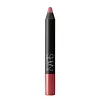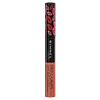What's inside
What's inside
 Key Ingredients
Key Ingredients

 Benefits
Benefits

 Concerns
Concerns

 Ingredients Side-by-side
Ingredients Side-by-side

C12-13 Alkyl Ethylhexanoate
EmollientSynthetic Candelilla Wax
EmollientPolyethylene
AbrasiveCaprylyl Methicone
Skin ConditioningCyclopentasiloxane
EmollientSilica
AbrasiveDimethicone
EmollientSucrose Acetate Isobutyrate
Hydrogenated Coco-Glycerides
EmollientDisteardimonium Hectorite
StabilisingPropylene Carbonate
SolventLecithin
EmollientMethylparaben
PreservativePropylparaben
PreservativeAroma
Tocopherol
AntioxidantAscorbyl Palmitate
AntioxidantDicalcium Phosphate
AbrasiveCitric Acid
BufferingBHT
AntioxidantAnise Alcohol
PerfumingMica
Cosmetic ColorantCI 77891
Cosmetic ColorantCI 77491
Cosmetic ColorantCI 77492
Cosmetic ColorantCI 77499
Cosmetic ColorantCI 15850
Cosmetic ColorantCI 19140
Cosmetic ColorantC12-13 Alkyl Ethylhexanoate, Synthetic Candelilla Wax, Polyethylene, Caprylyl Methicone, Cyclopentasiloxane, Silica, Dimethicone, Sucrose Acetate Isobutyrate, Hydrogenated Coco-Glycerides, Disteardimonium Hectorite, Propylene Carbonate, Lecithin, Methylparaben, Propylparaben, Aroma, Tocopherol, Ascorbyl Palmitate, Dicalcium Phosphate, Citric Acid, BHT, Anise Alcohol, Mica, CI 77891, CI 77491, CI 77492, CI 77499, CI 15850, CI 19140
Isododecane
EmollientTrimethylsiloxysilicate
EmollientDimethicone
EmollientC9-13 Isoparaffin
SolventDisteardimonium Hectorite
StabilisingCI 77120
Cosmetic ColorantAluminum Hydroxide
EmollientPropylene Carbonate
SolventSilica
AbrasivePropylparaben
PreservativePhenoxyethanol
PreservativeTin Oxide
AbrasiveBenzoic Acid
MaskingCalcium Aluminum Borosilicate
Mica
Cosmetic ColorantCI 77891
Cosmetic ColorantIron Oxides
CI 45410
Cosmetic ColorantCI 12085
Cosmetic ColorantCI 15850
Cosmetic ColorantCI 77163
Cosmetic ColorantCI 75470
Cosmetic ColorantRicinus Communis Seed Oil
MaskingCera Alba
EmollientPentaerythrityl Stearate/Caprate/Caprylate/Adipate
EmollientTocopheryl Acetate
AntioxidantParfum
MaskingAlcohol
AntimicrobialIsopropyl Myristate
EmollientTocopherol
AntioxidantCaprylic/Capric Triglyceride
MaskingAscorbyl Palmitate
AntioxidantAscorbic Acid
AntioxidantCitric Acid
BufferingBHT
AntioxidantIsododecane, Trimethylsiloxysilicate, Dimethicone, C9-13 Isoparaffin, Disteardimonium Hectorite, CI 77120, Aluminum Hydroxide, Propylene Carbonate, Silica, Propylparaben, Phenoxyethanol, Tin Oxide, Benzoic Acid, Calcium Aluminum Borosilicate, Mica, CI 77891, Iron Oxides, CI 45410, CI 12085, CI 15850, CI 77163, CI 75470, Ricinus Communis Seed Oil, Cera Alba, Pentaerythrityl Stearate/Caprate/Caprylate/Adipate, Tocopheryl Acetate, Parfum, Alcohol, Isopropyl Myristate, Tocopherol, Caprylic/Capric Triglyceride, Ascorbyl Palmitate, Ascorbic Acid, Citric Acid, BHT
Ingredients Explained
These ingredients are found in both products.
Ingredients higher up in an ingredient list are typically present in a larger amount.
Ascorbyl Palmitate is created by combining pure Vitamin C and palmitic acid. It is an antioxidant and helps reduce hyperpigmentation.
This ingredient is a more stable version of Vitamin C, meaning it does not disintegrate as quickly when exposed to sunlight. However, studies show it does not penetrate skin as well as pure Vitamin C.
Ascorbyl Palmitate is oil soluble.
Read more about other types of Vitamin C:
Learn more about Ascorbyl PalmitateBHT is a synthetic antioxidant and preservative.
As an antioxidant, it helps your body fight off free-radicals. Free-radicals are molecules that may damage your skin cells.
As a preservative, it is used to stabilize products and prevent them from degrading. Specifically, BHT prevents degradation from oxidation.
The concerns related to BHT come from oral studies; this ingredient is currently allowed for use by both the FDA and EU.
However, it was recently restricted for use in the UK as of April 2024.
Learn more about BHTCi 15850 is the pigment color red. It is an azo dye and created synthetically.
Azo dyes need to be thoroughly purified before use. This allows them to be more stable and longer-lasting.
This ingredient is common in foundations, lipsticks, and blushes. This color is described as brown/orangey red.
It has many secondary names such as Red 6 and Red 7. According to a manufacturer, Red 6 usually contains aluminum.
Learn more about CI 15850Ci 77891 is a white pigment from Titanium dioxide. It is naturally found in minerals such as rutile and ilmenite.
It's main function is to add a white color to cosmetics. It can also be mixed with other colors to create different shades.
Ci 77891 is commonly found in sunscreens due to its ability to block UV rays.
Learn more about CI 77891Citric Acid is an alpha hydroxy acid (AHA) naturally found in citrus fruits like oranges, lemons, and limes.
Like other AHAs, citric acid can exfoliate skin by breaking down the bonds that hold dead skin cells together. This helps reveal smoother and brighter skin underneath.
However, this exfoliating effect only happens at high concentrations (20%) which can be hard to find in cosmetic products.
Due to this, citric acid is usually included in small amounts as a pH adjuster. This helps keep products slightly more acidic and compatible with skin's natural pH.
In skincare formulas, citric acid can:
While it can provide some skin benefits, research shows lactic acid and glycolic acid are generally more effective and less irritating exfoliants.
Most citric acid used in skincare today is made by fermenting sugars (usually from molasses). This synthetic version is identical to the natural citrus form but easier to stabilize and use in formulations.
Read more about some other popular AHA's here:
Learn more about Citric AcidDimethicone is a type of synthetic silicone created from natural materials such as quartz.
What it does:
Dimethicone comes in different viscosities:
Depending on the viscosity, dimethicone has different properties.
Ingredients lists don't always show which type is used, so we recommend reaching out to the brand if you have questions about the viscosity.
This ingredient is unlikely to cause irritation because it does not get absorbed into skin. However, people with silicone allergies should be careful about using this ingredient.
Note: Dimethicone may contribute to pilling. This is because it is not oil or water soluble, so pilling may occur when layered with products. When mixed with heavy oils in a formula, the outcome is also quite greasy.
Learn more about DimethiconeDisteardimonium Hectorite comes from the clay mineral named hectorite. It is used to add thickness to a product.
It can also help stabilize a product by helping to disperse other ingredients.
Hectorite is a rare, white clay mineral.
Learn more about Disteardimonium HectoriteMica is a naturally occurring mineral used to add shimmer and color in cosmetics. It can also help improve the texture of a product or give it an opaque, white/silver color.
Serecite is the name for very fine but ragged grains of mica.
This ingredient is often coated with metal oxides like titanium dioxide. Trace amounts of heavy metals may be found in mica, but these metals are not harmful in our personal products.
Mica has been used since prehistoric times throughout the world. Ancient Egyptian, Indian, Greek, Roman, Aztec, and Chinese civilizations have used mica.
Learn more about MicaThis ingredient is a solvent. It helps dissolve active ingredients and alter the texture of products.
Propylene Carbonate is commonly used in makeup and with clay, such as montmorillonite or bentonite.
Studies show this ingredient to be safe for cosmetics. When it is undiluted, it can cause skin irritation. (It is always diluted in skincare and makeup). This ingredient is water-soluble.
Propylene Carbonate is created from propylene glycol and carbonic acid.
Learn more about Propylene CarbonatePropylparaben is a preservative and is a paraben with antifungal and antimicrobial properties.
This ingredient can be naturally found in plants and insects, but most of it is synthetically manufactured for human use. In cosmetics, it is usually created by reacting para-aminobenzoic acid and propanol (an alcohol).
You can usually find this ingredient in water-based products.
Parabens have come under controversy due to the claim they are hormone disruptors. Studies show conflicting results. We recommend speaking with a professional if you have any concerns.
Propylparaben is commonly found in food, medicine, and cosmetics.
Learn more about PropylparabenSilica, also known as silicon dioxide, is a naturally occurring mineral. It is used as a fine, spherical, and porous powder in cosmetics.
Though it has exfoliant properties, the function of silica varies depending on the product.
The unique structure of silica enhances the spreadability and adds smoothness, making it a great texture enhancer.
It is also used as an active carrier, emulsifier, and mattifier due to its ability to absorb excess oil.
In some products, tiny microneedles called spicules are made from silica or hydrolyzed sponge. When you rub them in, they lightly polish away dead skin layers and enhance the penetration of active ingredients.
Learn more about SilicaTocopherol (also known as Vitamin E) is a common antioxidant used to help protect the skin from free-radicals and strengthen the skin barrier. It's also fat soluble - this means our skin is great at absorbing it.
Vitamin E also helps keep your natural skin lipids healthy. Your lipid skin barrier naturally consists of lipids, ceramides, and fatty acids. Vitamin E offers extra protection for your skin’s lipid barrier, keeping your skin healthy and nourished.
Another benefit is a bit of UV protection. Vitamin E helps reduce the damage caused by UVB rays. (It should not replace your sunscreen). Combining it with Vitamin C can decrease sunburned cells and hyperpigmentation after UV exposure.
You might have noticed Vitamin E + C often paired together. This is because it is great at stabilizing Vitamin C. Using the two together helps increase the effectiveness of both ingredients.
There are often claims that Vitamin E can reduce/prevent scarring, but these claims haven't been confirmed by scientific research.
Learn more about Tocopherol